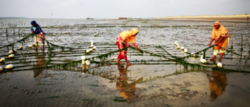
Algae can play a greater role in food security and nutrition
Editor/Mohamed Shihab
It's a booming business, it's good for your health and the environment, and it has the potential to play a greater role in feeding the world's growing population. Algae production is now worth $15 billion and cultivation is growing every year.In 2020, farmed algae contributed nearly 30 percent or 35.1 million tonnes to world aquaculture production, according to SOFIA. A simple seaweed has the potential to help efforts to fight hunger and deliver economic and social benefits. It is also more sustainable than other forms of agriculture.Algae, particularly macroalgae (commonly known as seaweeds), are an important component of aquaculture which is the fastest growing food sector. Asia accounts for 98.9 percent of cultivation but nearly 100 countries cultivate and export various types of seaweeds.
Growth in cultivation and demand
Global cultivation of algae, dominated by marine seaweeds, grew by half a million tonnes in 2020, up 1.4 percent from 34.6 million tonnes in 2019. Some major producing countries including China, Japan, the Republic of Korea, Indonesia and the Philippines.Alessandro Lovatelli, FAO fisheries and aquaculture officer, says growing demand is driving an increase in cultivation."Seaweeds have been widely consumed in Eastern Asia and the Pacific Islands for centuries, while they are still largely niche or novel foods in other parts of the world," says Lovatelli.
"There is an increasing awareness about seaweed as a food item. Now these products are being introduced in other countries as part of Asian cuisine and have gained increasing global popularity.
"You only have to look at the expansion of the sushi industry. Years ago there were no sushi restaurants in Italy, for example, and now they are far more common."Most seaweed production is supported by aquaculture. In 1970, the 2.2 million tonnes of world seaweed production came almost equally from wild collection and cultivation. A half century later, the wild collection was dwarfed by the farmed production of 35.1 million tonnes, accounting for 97 percent of world total seaweed production in 2020.
Health and economic benefits
Seaweeds and microalgae already generate socio-economic benefits for tens of thousands of households, primarily in coastal communities, where women too are empowered by seaweed cultivation. The health benefits of algae are also significant for consumers."Since most seaweed species contain no toxins, there are about 700 edible seaweed species," Lovatelli says. "They are generally rich in dietary fibre, micronutrients and bioactive compounds."
Seaweeds generally have a low level of fat while some seaweed species have high protein content. Research shows they improve gut health and can reduce the risks of non-communicable diseases such as obesity and diabetes.But cultivation is not just for human consumption. Seaweeds have many other uses in food and non-food industries, such as animal feeds, pharmaceuticals, nutraceuticals, cosmetics, textiles, biofertilizer/biostimulants, bio-packaging, and biofuel.
Algae is environmentally sustainable
The environmental benefits of seaweeds and microalgae have also generated plenty of attention.
Microalgae can be grown in freshwater or marine environments, depending on the species, and cultivated in marginal land in desert and arid areas. By extracting nutrients such as nitrogen and phosphorus from surrounding waters and absorbing carbon dioxide, the photosynthetic process of seaweeds and microalgae can mitigate eutrophication, treat wastewater, reduce ocean acidification and capture/sequester carbon.
Algae also provide habitats for fish and other marine organisms, create a buffer against strong wave action to protect the shoreline and reduce overfishing by providing alternative livelihoods to fishing communities.
FAO's role in developing the sector
FAO is working with governments, the industry, the scientific community, international organizations, civil societies, and other stakeholders or experts to further the potential of seaweeds and microalgae contribution to global food security."There are opportunities to engage with fisheries communities and give them business opportunities, and employment, while involving women in both farming and processing, and providing business opportunities to youth," says Lovatelli.
Science and innovation have been the main driving force behind breakthroughs in seaweed and microalgae development. Innovations in seedling production, development of longline cultivating systems for kelp farming, and technology for extracting quality agar for soaps and cosmetics, and production of biofertilizers are among the examples that have made a difference.Genetic improvement technologies, such as strain selection, selective breeding and micropropagation - also known as tissue culture - can help improve growth. However, these tend to be technical and financially demanding and often require public support.
"There has been quite a lot done with genetics to improve farm strains that enhance the growth of certain species of seaweeds," says Lovatelli. "Now countries, for example in Europe, are looking into product diversification to support the consumption of seaweed to make it more acceptable to different people from different cultures."
FAO supports closer collaborations between the algae industry and the research community to transform the extensive potential of seaweeds and microalgae.Public sector support and financial incentives are also needed to support the development and commercialization of innovations that will have significant technical, economic, environmental and social benefits.


ساحة النقاش